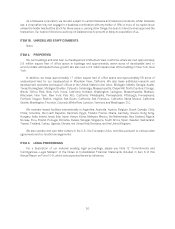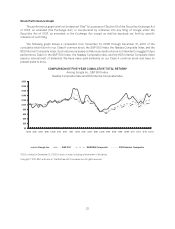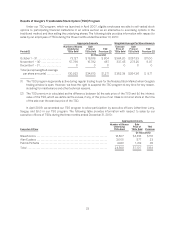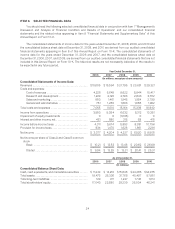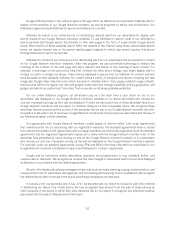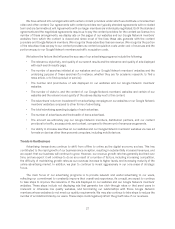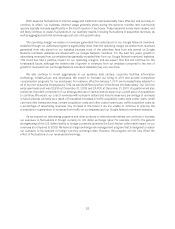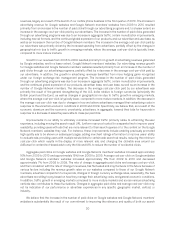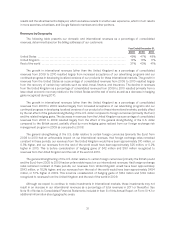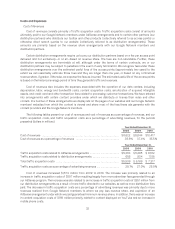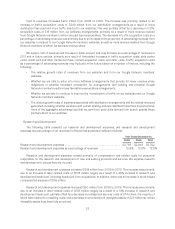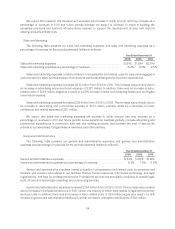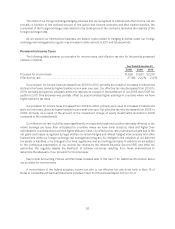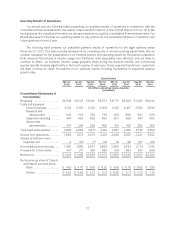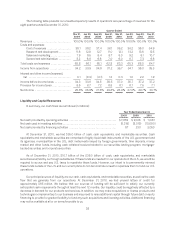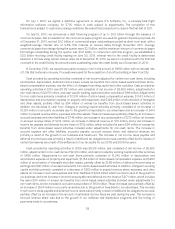Google 2010 Annual Report Download - page 43
Download and view the complete annual report
Please find page 43 of the 2010 Google annual report below. You can navigate through the pages in the report by either clicking on the pages listed below, or by using the keyword search tool below to find specific information within the annual report.revenues, largely as a result of the launch of our mobile phone business in the first quarter of 2010. The increase in
advertising revenue for Google websites and Google Network members’ websites from 2009 to 2010 resulted
primarily from an increase in the number of paid clicks through our advertising programs and, to a lesser extent, an
increase in the average cost-per-click paid by our advertisers. The increase in the number of paid clicks generated
through our advertising programs was due to an increase in aggregate traffic, certain monetization improvements,
including new ad formats, and the continued global expansion of our products, and our advertiser and user base, as
well as an increase in the number of Google Network members. The increase in the average cost-per-click paid by
our advertisers was primarily driven by the increased spending from advertisers, partially offset by the changes in
geographical mix due to traffic growth in emerging markets, where the average cost-per-click is typically lower,
compared to more mature markets.
Growth in our revenues from 2008 to 2009 resulted primarily from growth in advertising revenues generated
by Google websites, and to a lesser extent, Google Network members’ websites. Our advertising revenue growth
for Google websites and Google Network members’ websites resulted primarily from an increase in the number of
paid clicks through our advertising programs, partially offset by a decrease in the average cost-per-click paid by
our advertisers. In addition, the growth in advertising revenues benefited from more hedging gains recognized
under our foreign exchange risk management program. The increase in the number of paid clicks generated
through our advertising programs was due to an increase in aggregate traffic, certain monetization improvements,
and the continued global expansion of our products, advertiser base, and user base, as well as an increase in the
number of Google Network members. The decrease in the average cost-per-click paid by our advertisers was
primarily the result of the general strengthening of the U.S. dollar relative to foreign currencies (principally the
British pound and the Euro), as well as changes in geographical mix due to traffic growth in emerging markets,
where the average cost-per-click is typically lower, compared to more mature markets. In addition, the decrease in
the average cost-per-click was due to changes in how we believe advertisers managed their advertising costs in
response to the uncertain economic conditions in 2008 and 2009. Specifically, we believe that, as a result of the
economic downturn and the economic uncertainty, advertisers, in aggregate, lowered their bids for keywords in
response to a decrease in sales they were able to make per paid click.
Improvements in our ability to ultimately monetize increased traffic primarily relate to enhancing the user
experience, including moving the search result URL (uniform resource locator) to a separate line to improve users’
readability, providing users with ads that are more relevant to their search queries or to the content on the Google
Network members’ websites they visit. For instance, these improvements include enabling previously promoted
high quality ads to be shown on subsequent pages, adding merchant ratings information to improve users’ ability
to evaluate ads, providing users with multiple ad site links for certain web search ad results, reducing the minimum
cost-per-click which results in the display of more relevant ads, and changing the clickable area around our
AdSense for content text-based ads to only the title and URL to reduce the number of accidental clicks.
Aggregate paid clicks on Google websites and Google Network members’ websites increased approximately
16% from 2009 to 2010 and approximately 15% from 2008 to 2009. Average cost-per-click on Google websites
and Google Network members’ websites increased approximately 5% from 2009 to 2010 and decreased
approximately 7% from 2008 to 2009. The rate of change in aggregate paid clicks and average cost-per-click,
and their correlation with the rate of change in revenues, has fluctuated and may fluctuate in the future because of
various factors including the revenue growth rates on our websites compared to those of our Google Network
members, advertiser competition for keywords, changes in foreign currency exchange rates, seasonality, the fees
advertisers are willing to pay based on how they manage their advertising costs, and general economic conditions.
In addition, traffic growth in emerging markets compared to more mature markets and across various advertising
verticals also contributes to these fluctuations. Changes in aggregate paid clicks and average cost-per-click may
not be indicative of our performance or advertiser experiences in any specific geographic market, vertical, or
industry.
We believe that the increase in the number of paid clicks on Google websites and Google Network members’
websites is substantially the result of our commitment to improving the relevance and quality of both our search
30


